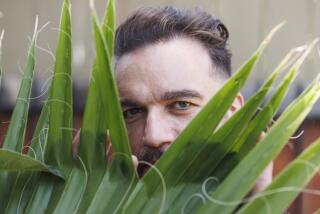Personal Narrative
- Share via
Terry Stanfill gardened for years before she wrote her first novel, “The Blood Remembers,” a lavish tale of self-discovery that moves from Santa Monica to Italy and back and forth between the present and the Middle Ages. Once Stanfill started writing, though, her love of plants appeared in prose while her novel’s themes began showing up in her landscape. “I’ve always dreamed of . . . having a sunny walled garden with a fountain splashing in the middle, climbing white roses all around,” muses the aptly named Rose Kirkland, heroine of Stanfill’s book.
Ten years ago, as Stanfill wrote these lines, they moved her to create her own “hortus conclusus,” a walled, medieval-style rose retreat on her Pasadena acre. Subsequently, she recalls, “I suddenly had to have olive trees, a pomegranate, grapevines”--all plants grown by Stanfill’s Italian forebears and all suitable for a California garden, especially one tailored for her 1912 house by landscape legend Ralph Cornell.
Unlike the fictional Rose, who tends potted citrus and geraniums on a Westside terrace, Stanfill had space enough for trees and hedges, rose swags and pergolas. Some of these existed in the garden when she and her husband Dennis, former chair and CEO of 20th Century Fox, bought their property in the mid-’60s. Behind the Beaux Arts-style house, designed by architect Robert Farquhar, myrtle hedges and white oleanders were both part of Cornell’s plan, says Stanfill, describing a sunken lawn flanked by apple trees and surrounded by the hedges. Over the years, the Stanfills replaced the lawn with a swimming pool for their children, Sara, Francesca and Dennis, and when the apples died of oak root fungus, they planted boxed evergreen pears. Still, a vast front lawn remained until, Stanfill says, “our last child left for college and took the dog.” It was also around that time that Stanfill, who had been a founding board member of the Los Angeles Opera and an international representative of Christie’s (a position she still holds), started her novel. As writing fired her imagination--and her passion for antiquity--she felt inspired to make the garden stronger and more evocative. “It needed more architecture and definition,” she reflects. “In a garden, as in a book, you have to weed out what blocks your narrative.”
A Connecticut native who has gardened since childhood, Stanfill sought help from a kindred spirit, designer James Yoch, the nephew of another early California landscape great, Florence Yoch, and an English professor at the University of Oklahoma. “He’s a scholar of Renaissance gardens,” Stanfill notes, and he helped her turn a French-flavored design more Italian by breaking spaces into rooms and linking these with straight paths and selective views through arched openings in the hedges.
From there, Stanfill painted in details: vibrant coral-pink ‘Tony Duquette’ roses, in honor of her late friend, the theatrical designer; a secret shade walk under swags of ‘Royal Sunset’ roses; a Neapolitan statue wreathed in solanum; the water music of her dreams. “The fountain by its murmur sings in praise of life” is stenciled on her fountain’s bricks. And more roses--hybrid teas, Romanticas, David Austins--are everywhere. “In the Middle Ages,” Stanfill says, “the rose was a mystical symbol, associated with courtly love.”
Another timeworn symbol is the boxwood labyrinth she planted three years ago in a corner of the former lawn. Signifying a directed journey to the center of the self, this fanciful walk, and the patterned potager nearby, grew out of Stanfill’s plotting for her third novel. “Being a gardener made me acutely aware of nature as a setting,” she observes. “And being a writer has moved me to infuse more history and layered time into my garden.”
A second statue, depicting the Greek muse of epic poetry, presides from a pedestal above her swimming pool. A small stone temple, built by hand in her ancestral town in southern Italy, graces a side garden, which Stanfill calls “the Garden of the Mists of Antiquity.” She has a “Garden of Eden,” with creamy ‘Eden’ roses and alpine strawberries, espaliered apples and winter lettuce. A vintage glass house holds seedlings and plants she raises for indoors: lilies, paperwhites and abutilons.
Every day, Stanfill wanders outside to think and to observe these scenes. “My writer’s mind is chaotic,” she admits. “My garden grounds me with its order.”
More to Read
Sign up for our Book Club newsletter
Get the latest news, events and more from the Los Angeles Times Book Club, and help us get L.A. reading and talking.
You may occasionally receive promotional content from the Los Angeles Times.









